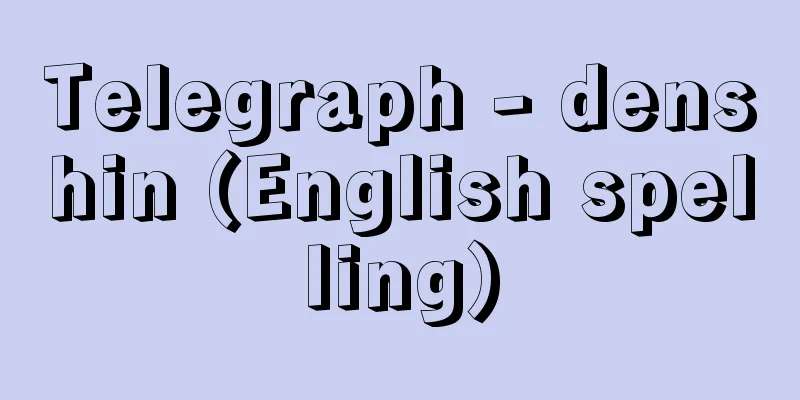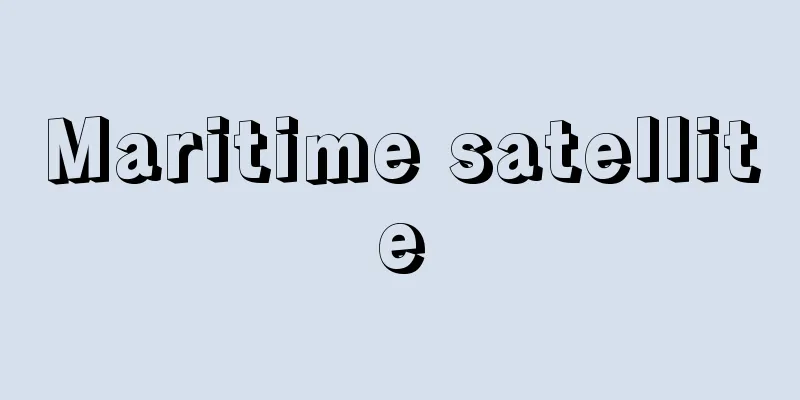Telegraph - denshin (English spelling)

|
A type of signal transmission method in telecommunications. Refers to the device that converts the text or images to be transmitted into electrical codes or signals and transmits or receives them, as well as the act of operating this device or the telegram that is delivered. [Iwao Ishijima] historyHumans have used signal fire and tom-toms as a means of communication for over 1000 years. When documents needed to be sent, they used fast horses and carrier pigeons. After the discovery of the law of attraction and repulsion of charged bodies or magnetic poles, known as Coulomb's law, by the Frenchman C. A. Coulomb in 1785, many researchers devised communication methods that applied static electricity, magnets, the magnetic effects of electric currents, and chemical changes caused by electric currents. Some of these were adopted by the British railways, but most were never put to practical use. Meanwhile, in 1793, C. Chappe of France succeeded in long-distance, high-speed communication over a distance of 230 km between Paris and Lille using a semaphore system. This involved using a telescope to observe changes in the shape of semaphores on tall towers set up approximately every 10 km, and then relaying the data; a similar system was also put into practical use in Britain. Electrical telegraphs were first put into practical use after the invention of the famous "Volta's battery" by Italian C. A. Volta. In 1837, British engineers W.F. Cook and C. Wheatstone patented a five-needle electromagnetic telegraph and conducted a communication experiment over a distance of 1.5 km. This was adopted by the Great Western Railway, and successfully put into practical use over a 21 km distance between London Paddington and West Drayton. By 1852, this system had completed a telegraph route of 6,500 km in the UK. Another great invention was the famous Morse code and the Morse telegraph, achieved in 1837 by the Americans S. F. B. Morse and Alfred Lewis Vail (1807-1859). Morse was an American painter who was appointed professor of art history at New York University in 1835. On a voyage after completing his studies in Europe in 1832, he was shown an electromagnet by a fellow passenger on board, and was very interested in it. He became convinced that it could be used as a sensing element in a telegraph. He invented the Morse code, and by combining it with Vail's mechanical skills, the Morse telegraph was born. In 1844, an experiment was conducted by laying a 64-kilometer electric wire between Washington DC and Baltimore, and the first telegraph message sent was "What hath God wrought." There is an anecdote that in 1963, U.S. President Kennedy used these words to conclude his first conversation with the Nigerian Prime Minister over a distance of 72,000 kilometers via the communications satellite Syncom. It was American Perry who first brought the Morse telegraph to Japan. It is said that he demonstrated a 1.6-kilometer telegraph in Yokohama in 1854 (Ansei 1). The first public telegraph line was established in January 1870 (December 1 of the lunar year Meiji 2) between Tokyo and Yokohama using a Breguet telegraph, and in September between Osaka and Kobe. At that time, telegraphs were in their early stages of practical use around the world, and telegraph lines were established between Bombay (now Mumbai) and Suez, London and Copenhagen, Paris and Berlin, Aden and Suez, and London and Calcutta (now Kolkata). In the United States, the length of domestic lines had reached 12,000 kilometers. In 1858, a 3,600-kilometer-long undersea telegraph line across the Atlantic was completed, but unfortunately it was shut down after about a month. [Iwao Ishijima] Wireless telegraphyWireless telegraphy was invented in 1896 by a young Italian named G. Marconi. Marconi's invention was achieved by utilizing the resonance phenomenon, a coherent detector, and Morse code, based on a thorough understanding of J.C. Maxwell's theory on electromagnetic waves and H.R. Hertz's experiments showing the existence of electromagnetic waves. This is also evident from the fact that during a demonstration held the following year in 1897, the words "HEINRICH HERTZ" were reportedly sent to the scientists watching. A notable achievement in the history of Japanese wireless telegraphy is its performance in the Battle of Tsushima during the Russo-Japanese War. At the end of May 1905 (Meiji 38), the patrol ship Shinano Maru discovered a large Russian fleet approaching the coast of Tsushima and sent out the famous wireless telegram "Enemy ships in sight," marking the beginning of a great victory. This was only 10 years after Marconi's successful experiments, and it is recorded that the wireless telegraph was built under the guidance of Kimura Shunkichi and Annaka Tsunejiro (1871-1913). After that, the First and Second World Wars saw such technological advances that they were called wars of communications. The invention of the vacuum tube dramatically extended the distance that telegraphs could travel, both wired and wireless, and helped to increase communication speeds by more than tenfold. Improvements in the performance of various components made it possible to stabilize frequencies and increase their frequency. All developments in science, technology and industry led to the development of communications technology, and communication devices increasingly played a role as weapons. The technological advances made in the 50 years since the end of World War II are too numerous to mention. The emergence of transistors, integrated circuits (ICs), and large-scale integrated circuits (LSIs) have made it possible to process digital signals at high speeds, enabling signal multiplexing, automation, storage, and conversion at levels never dreamed of by our predecessors. Currently, overseas communications from Japan are carried out by undersea cables and communications satellites, including broadband lines, with KDDI and other communications carriers sharing the bandwidth for effective use. Photo transmission, facsimile, and data transmission are also classified as telegraphs, and photo data sent from planetary observation satellites also belong to the category of telegraphs. [Iwao Ishijima] Telegraph in telecommunications businessUnder the Telecommunications Business Act, the previous public communications services are called telecommunications services. There is no need to call them public, as the government has prohibited monopolizing communications services. Telecommunications services are divided into telegraphs and telephones. Telegraphs, as is known from telegrams, are a form of communication in which a user writes a message and requests it to be delivered, which is then sent to the destination by a third party, encoded, and then decoded and converted back into text before being delivered to the recipient. Telegraphs are a form of communication in which a user communicates with a third party, and the message is sent to the destination by a third party, encoded, and then transmitted to the destination by a third party, and then decoded and converted back into text before being delivered to the recipient. Telegraphs are a conversation between users, but telegraphs usually require some time between the time of the request to send and the time of delivery. The shorter this time, the better, but since immediacy is not required as with telephones, it is possible to use the idle time of communication lines, thereby making effective use of their transmission capacity. Furthermore, since telegraphy is a form of communication that leaves a written record, it is a suitable method for accurately transmitting important instructions. [Iwao Ishijima] Telegraph operationTelegraph codes include Morse code, while printed telegraphs have 5-bit and 6-bit codes. 5-bit codes are used to transmit English text, while 6-bit codes are used to transmit both Japanese and English text. Printed telegraph transmission paths are multiplexed using methods such as frequency division and time division, allowing for broadband transmission. Individual users receive lines and equipment from Nippon Telegraph and Telephone (NTT) or KDDI, among others, which allows them to communicate directly with teletypes. This is called subscriber telegraph (telex), while printed telegraphs that use a dedicated communication line rented between a specific communication partner are called dedicated telegraphs. In the 1990s, Morse telegraphy was almost completely abandoned in developed countries, and two types of printing telegraphy are now used for maritime communication. One is the Narrowband Direct Printing Telegraph (NBDP) system using shortwave waves, known as the ARQ (automated request of repetition) system. This communication method uses shortwave circuits that are subject to severe fading (a phenomenon in which the reception of radio waves changes over time), and the receiving side automatically detects and requests retransmission of typos and omitted words. It has been in practical use in Europe and the United States since the 1960s, but in Japan, it was experimentally used in English only from 1981 (Showa 56). This method has a surprisingly low rate of typos and is considered to be very practical, but it has hardly been used in Japan, where radio telephones using Inmarsat (International Maritime Satellite System, now the International Mobile Telecommunications Satellite System) are preferred. Satellite communications are primarily used for telephone and telegraph (telex). Intelsat satellites are used for satellite relay between land and ships, while Inmarsat satellites are used for satellite relay between land and ships. Early satellite communications on ships tended to be a little too idealistic, and in the Inmarsat A system, the control required to keep the parabolic antenna on a rocking ship always pointed at a geostationary satellite was quite complicated. However, this system allowed instantaneous connection between the ship and the subscriber telegraph equipment on land using high-speed printing telegraphs, and there is no doubt that it brought about a revolutionary advancement in ship communications. After that, it was gradually simplified by removing some of its performance, and was miniaturized to become Inmarsat B and Inmarsat C, which quickly became popular. Another example of maritime communications that has become extremely popular is the duplicative telegraph system, a type of facsimile that operates on shortwave frequencies and, since the late 1950s, has been used to receive weather charts and newspapers on board ships, helping to ensure the safety of voyages and enrich the lives of crew members. [Iwao Ishijima] The evolution of maritime communicationsDespite the development of print telegraph and satellite communication, the Morse communication system remained the most important communication method for maritime communication until January 1999. In 1912, shortly after the invention of wireless telegraph by Marconi, the British luxury liner Titanic disaster occurred, resulting in the deaths of over 1,500 people. It became clear that the cause of the disaster was poor wireless telegraph operation, and the importance of wireless telegraphs on ships was recognized. Based on this recognition, a conference of the administrations of the International Radiotelegraph Union was convened in London to establish global regulations for the operation of wireless communication at sea. Thus, the International Convention for the Safety of Life at Sea and the International Radiotelegraph Convention were concluded, and the idea of prioritizing maritime communication, especially distress communication, over all other communication was established. This philosophy is reflected in the Radio Regulations attached to the Telecommunications Convention up until 1992, as well as in Japan's domestic laws such as the Radio Law and the Ship Safety Law. According to these regulations, large ships engaged in long-distance voyages were required to install transmitting equipment capable of manually and automatically sending distress signals in Morse code using radio waves with a distress frequency of 500 kHz, which is the most ideal communication equipment, and receiving equipment capable of hearing the Morse code on the distress frequency, and were required to appoint radio operators with first or second class radio operator qualifications. This was an extremely strict treaty in which ships were not allowed to set sail for foreign destinations unless they could prove that this 500 kHz radiotelegraph transmitting equipment had a communication range of more than 190 nautical miles (about 352 km) during the daytime. Medium wave radio waves such as 500 kHz can always be received stably within communication distance, so the system for receiving distress alerts and emergency communications, which combines auditory listening and automatic reception (auto-alarm), was perfect, and it was certain that ships around the world were sailing in a system that could respond immediately to any marine accidents that occurred within 190 nautical miles. However, technological advances have brought about a time when the Morse communication system will collapse. The world's shipping industry, led by the International Maritime Organization (IMO), has been studying how ships should be operated rationally in line with advances in science and technology, and has named this research the "Futures Global Maritime Distress and Safety System" (FGMDSS). Since around 1975, the IMO's Radiocommunication Committee, the World Radiocommunication Conference (WMRC) of the International Telecommunication Union (ITU), and the Consultative Committee for International Radiocommunication (formerly CCIR, now integrated into ITU-R) have been researching reforms to maritime radio communication. Regarding distress communications, the government concluded that radio telegraphy, which uses 500 kHz, has a communication distance of only about 350 kilometers, and that in the future, if a person is in distress anywhere in the world, it will be necessary to be able to know about it instantly on land. In addition, sending and receiving Morse code requires extensive training, and it would be inconvenient if distress communications could only be carried out by radio operators with special skills. As a result, it was decided to discontinue the use of Morse radio telegraphy for distress communications. [Iwao Ishijima] Satellite-based distress communication systemAs an alternative distress communication system, the following satellite communication system was devised. It involves placing Cospas-Sarsat satellites (Cospas is a Russian satellite, and Sarsat is an American satellite, with four of each) in polar orbit at low altitude. All ships are fitted with an Emergency Position Indicating Radio Beacon (EPIRB) on the outside of the ship, and if a ship sinks in distress and the EPIRB reaches four meters below the sea surface, a water pressure sensor is activated to raise the EPIRB to the surface and emit a 406 MHz radio wave from the sea surface. This signal is a digital signal, and the Cospas-Sarsat satellite measures the position of the ship in distress using the Doppler effect (the phenomenon in which the frequency of the signal changes due to a rapid change in the positional relationship from the source of the radio wave) caused by its own orbital movement, adds the position information, and relays it to a local user's terminal (LUT), a receiving station on land, as a 1.6 GHz digital signal radio wave. There are 30 LUT stations installed around the world, and ships sailing in the area are required to radio their location information to the rescue organization responsible for that area once a day. The LUT receives distress calls relayed by satellite and identifies from the list ships sailing near the ship in distress and requests rescue. This system was approved by the majority of countries in the world, and was called GMDSS, with the letter "F" (which means "future") removed, and was gradually implemented on newly built ships from February 1992. Although some countries opposed it, the interests of so-called developed countries were prioritized. From the beginning, the goal of full implementation of GMDSS was February 1999, but even at this point, many developing countries were slow to respond, and coastal stations were not equipped with the necessary equipment. However, IMO placed importance on the wishes of its member developed countries and fully implemented GMDSS on the scheduled date. Communications personnel on GMDSS ships do not need to be qualified as first-class general radio operators, but only third-class marine radio operators are required, so if navigators or other personnel obtain the qualifications, they can communicate. In Japan, the Japan Coast Guard's Enkaisan Communications Control Office (Isogo, Yokohama) serves as the LUT, and the received signals are connected to the Japan Coast Guard's communications station (Tokyo JNA) located in the Ministry of Land, Infrastructure, Transport and Tourism Joint Government Building in Kasumigaseki, Tokyo. This radio station is responsible for controlling maritime accidents that occur in the sea area bounded by the continental coast and the line 17 degrees north latitude and 165 degrees east longitude. GMDSS is not completed by only the COSPAS-SARSAT satellite and EPIRB, but needs to be duplicated in case of an emergency. For this purpose, the 2183.5 kHz SSB radiotelephone system and shortwave frequency shift DSC (Digital Selective calling) are considered, and then distress messages are sent by switching to shortwave SSB radiotelephone, narrowband direct printing telegraph, international VHF (very high frequency) radiotelephone, etc. In this case, it is expected that no ships will choose Morse communication for general communication, so it was thought that Morse communication would disappear from the world of maritime communication after 1999. [Iwao Ishijima] Systemic problems and international responsibilityIn Japan, NTT's Nagasaki Radio Station stopped all Morse code telecommunication services on January 31, 1999, and all distress, emergency, and safety communications were handed over to the Japan Coast Guard. Developed countries showed no interest in measures for developing countries' ships that had not yet transitioned. Japan also has major problems with GMDSS, especially in the case of fishery radio, where there is no goal set for transition measures for radio equipment on ocean-going fishing vessels. The reason for this is that holders of the third-class general radio operator qualification, who have worked as radio operators on ocean-going fishing vessels, will not be able to work on the same fishing vessel's radio station after the transition unless they are promoted to the third-class marine radio operator qualification. The languages that can be used for international radio calls, including distress communications, are English, French, Spanish, and Chinese, and no other languages can be used. To be promoted to a third-class marine radio operator, a national examination requires English (including conversation), but the level of the questions is set at the same level as that of the highest first-class general (or marine) radio operator, making it an extremely high hurdle. This causes a shortage of radio operators in the fishing industry of over 5,000 people, meaning that fishing boats equivalent to that number cannot confidently operate in distant ocean waters. I wonder if those involved realized how difficult it would be to provide English re-education to the 5,000 radio operators currently aboard fishing boats and bring them up to the level of a university graduate. Since most Japanese fishing boats cannot adapt to the new system except for the installation of EPIRBs, a temporary measure agreed between the government and the private sector has been put in place to allow third-class general radio operators to continue working at radio stations on ocean-going fishing boats, on the condition that all digital information (weather reports, marine notices, navigation warnings, etc.) transmitted from land to the sea is translated into Morse code by the fishing coastal station and retransmitted, barely enabling fishing operations. For this reason, about 20 large fishing coastal stations in Japan and many of their fishing boats are operating with Morse code for the time being. This protects the safety of fishing boats domestically, but it does not allow Japan to fulfill its international responsibilities. As of 2011, this transitional measure has been in place for more than 10 years, but unless someone takes action, it will seriously damage Japan's international credibility. The current status of the transition to GMDSS in Japanese waters is that Japan completed the transition for general coastal stations and commercial ship radio stations on the same day, but coastal stations and their associated ships in Korea, China, and Taiwan have been communicating with Morse code for several years. As of 2011, only Korea maintains radiotelegraph coastal stations and communicates with ships using Morse code. Korea is not in a situation where it cannot transition technically or economically, so this measure is likely based on deep consideration. The biggest concern after the transition was the extremely high number of false EPIRB signals that were reported. In fact, it has been reported that more than 90% of distress alerts received via satellite at LUTs around the world are false signals that do not involve any distress, and RCCs around the world are also plagued by DSC false signals from ships. Even today in 2011, this system seems to have become a "boy who cried wolf," and there is no need to bring up the Titanic, but at the very least, it cannot be left as it is. [Iwao Ishijima] Radio operator qualification systemThe Radio Law stipulates that radio communication operations may only be carried out under the supervision of a radio operator who holds some kind of radio operator qualification, determined by the type of radio station and transmission power, or a chief radio operator appointed by the radio station. There are 23 levels of radio communication qualifications, ranging from the highest qualification, First Class General Radio Operator, to Fourth Class Amateur Radio Operator. First Class General Radio Operator, Second Class General Radio Operator, Third Class General Radio Operator, First Class Marine Radio Operator, Second Class Marine Radio Operator, Third Class Marine Radio Operator, Fourth Class Marine Radio Operator, First Class Marine Special Radio Operator, Second Class Marine Special Radio Operator, Third Class Marine Special Radio Operator, Radar Class Marine Special Radio Operator, Aeronautical Radio Operator, Aeronautical Special Radio Operator, First Class Land Radio Operator, Second Class Land Radio Operator, First Class Land Special Radio Operator, Second Class Land Special Radio Operator, Third Class Land Special Radio Operator, Domestic Telegraph Class Land Special Radio Operator, First Class Amateur Radio Operator, Second Class Amateur Radio Operator, Third Class Amateur Radio Operator, Fourth Class Amateur Radio Operator. In addition, the qualification required for radio operators to be appointed to radio stations on ocean-going ships under GMDSS is a third-class maritime radio operator, and the national examination does not require a practical Morse communication test. The technical ability test is lower than that of a third-class general radio operator, but the English test requires a high level of ability equivalent to that of a first-class general radio operator. [Iwao Ishijima] [References] | | | | | | | | | | |Source: Shogakukan Encyclopedia Nipponica About Encyclopedia Nipponica Information | Legend |
|
電気通信における信号伝送方式の一種。伝送しようとする文言・画像などを電気的な符号や信号に変換して送信し、または受信する装置、およびこれを運用する行為、または送達された電報をいう。 [石島 巖] 歴史人類は1000年以上も前から、のろしやトム・トム(太鼓)などを通信の手段としてきた。文書を送る必要があるときは早馬(はやうま)や伝書鳩(でんしょばと)などがその手段となった。1785年にフランスのC・A・クーロンによって帯電体または磁極の引力斥力の法則、いわゆるクーロンの法則が発見されたのち、多数の研究者が静電気、磁石、電流の磁気作用、電流による化学変化などを応用する通信方法を考案した。これらの一部は、イギリスの鉄道に採用されたが、ほとんど実用化されることなく推移した。 一方、1793年にフランスのC・シャップは、セマホールsemaphoreとよばれる腕木(うでぎ)通信によって、パリとリール間で230キロメートルに及ぶ遠距離高速通信に成功した。これは、約10キロメートルごとに設けた高い塔の上の腕木の形の変化を望遠鏡で観測して、これを中継するもので、類似の方式がイギリスでも実用化された。 電気を用いる電信といえるものは、イタリアのC・A・ボルタによって有名な「ボルタの電池」が発明されたあとに実用化されている。 イギリスのW・F・クックとC・ホイートストンは1837年に5針電磁式電信機の特許をとり、1.5キロメートルの距離の通信実験を行った。これがグレート・ウェスタン鉄道に採用され、ロンドンのパディントンとウェスト・ドレイトン間21キロメートルの実用化に成功した。このシステムは1852年ごろにはイギリス内において6500キロメートルの電信路を完成するまでになっていた。 もう一つの偉大な発明は、アメリカのS・F・B・モースとベイルAlfred Lewis Vail(1807―1859)によって1837年に成し遂げられた有名なモールス符号およびモールス電信機である。 モースはアメリカの画家であり、1835年にニューヨーク大学の美術史の教授として迎えられた。1832年にヨーロッパ留学を終えての船旅のおり、乗り合わせた船客に見せられた電磁石に大きな興味をもち、電信機の感応素子として利用できるという確信を得た。そしてモールス符号を考案し、ベイルのもつ機械についての能力と結び付くことによってモールス電信機が誕生した。1844年ワシントンDCとボルティモア間の64キロメートルに電線を敷いて行われた実験において最初に送られた電文は「神のなせし業(わざ)」What hath God wroughtであった。1963年にアメリカの大統領ケネディが通信衛星シンコムによるナイジェリアの総理大臣との7万2000キロメートルを隔てた最初の会話を、このことばで結んだという逸話が残っている。 日本に最初にモールス電信機をもたらしたのは、アメリカのペリーである。1854年(安政1)に横浜において1.6キロメートルの通信実演を行ったと伝えられている。最初の公衆通信は、1870年1月(陰暦明治2年12月)に東京と横浜間でブレゲー電信機によって開通し、9月には大阪と神戸間で開通した。当時世界では電信が実用期に入っており、ボンベイ(現、ムンバイ)―スエズ間、ロンドン―コペンハーゲン間、パリ―ベルリン間、アデン―スエズ間、ロンドン―カルカッタ(現、コルカタ)間、などに電信回線が開通。アメリカでも国内の回線の延長が1万2000キロメートルにも達していた。1858年には、延長3600キロメートルの大西洋海底電信線が完成したが、約1か月で不運にも不通となったといわれる。 [石島 巖] 無線電信無線による電信はイタリアの青年G・マルコーニによって1896年に発明された。マルコーニの発明はJ・C・マクスウェルの電磁波に関する理論と、H・R・ヘルツによる電磁波の存在を示す実験を熟知してのうえで、共振現象とコヒーラー検波器を利用し、モールス符号を使用することによって達成された。翌1897年に行われたデモンストレーションの際、これを見守る科学者の前に送られてきた文字は“HEINRICH HERTZ”であったと伝えられているのも、この事情を物語るものである。 日本の無線電信の歴史のなかで特筆すべきものは、日露戦争での日本海海戦における活躍である。1905年(明治38)5月末、哨戒艦(しょうかいかん)信濃丸(しなのまる)は対馬(つしま)の沖に近づくロシアの大艦隊を発見し、有名な「敵艦見ゆ」という無線電信を発して大勝利の端緒を開いた。マルコーニが実験に成功してからわずか10年後のことであり、無線電信機は木村駿吉(きむらしゅんきち)と安中常次郎(あんなかつねじろう)(1871―1913)の指導によって製作されたと記録されている。 その後、第一次、第二次の世界大戦では通信の戦争といわれるほどの技術的進歩をみるのであるが、真空管の発明は有線・無線を問わず電信の通達距離を飛躍的に伸ばし、通信速度を10倍以上もあげることに役だった。各種部品の性能向上は、周波数の安定化、高周波化を可能とした。すべての科学技術や工業の発展が通信技術の発展につながり、通信機は兵器としての役割を強めていった。 第二次世界大戦後の50年間の技術の進歩は、枚挙にいとまがない。トランジスタ、IC(集積回路)、LSI(大規模集積回路)の登場によってデジタル信号の高速処理が可能となり、信号の多重化、自動化、記憶、変換など、先人たちが夢想だにしなかったようなレベルにまで到達した。 現在、日本からの対外通信は海底ケーブルと通信衛星とによって行われているが、広帯域回線を含み、KDDIや各通信事業者が帯域を分け合って有効に利用している。写真電送、ファクシミリ、データ伝送も電信の部類に含まれ、惑星観測衛星から送信される写真データも電信の部類に属するのである。 [石島 巖] 電気通信業務における電信電気通信事業法では従来の公衆通信業務を電気通信業務という。通信業務の官による独占を禁じたため、公衆と呼称する必要がないからである。その電気通信業務は電信と電話に分けられている。電信は電報で知られるように利用者が文字で書いて送達を依頼した原稿を第三者が仲介し、符号化して目的地まで伝送ののち、復号して文字に直したうえで受信人に配達する形態の通信である。電話は利用者相互の対話であるが、電信は送信依頼の時刻と配達の時刻との間に通常いくらかの時間が必要である。この時間は短ければ短いほどよいが、電話のように即時性は要求されないから、通信回線の空き時間を利用できるため、その伝送能力を効果的に活用できる。 また電信は文書として記録に残される形態の通信であるから、重要な指令を正確に伝達するような場合に適した方式であるといえる。 [石島 巖] 電信の運用電信の符号にはモールス符号があり、印刷電信には5単位符号と6単位符号とがある。5単位符号は英文の伝送に、6単位符号は和文と英文の伝送に使用される。印刷電信の伝送路は周波数分割、時分割などの方法で多重化され広帯域伝送となっている。個々の利用者は日本電信電話(NTT)またはKDDIなどから回線と設備の提供を受け、これによって直接テレタイプ通信を行うことができる。これを加入電信(テレックス)とよび、特定の通信相手との間に専用の通信回線を借り受けて行う印刷電信を専用電信とよぶ。 1990年代に入るとモールス電信は先進国ではほとんど使用されなくなり、海上通信も印刷電信が二つの形態で運用されている。一つはARQ(automated request of repetitionの略、自動誤字訂正方式)システムという短波を使用しての狭帯域直接印刷電信(NBDP)システムである。この通信方式は、フェージング(電波の受信状態が時間的に変化する現象)の激しい短波回線を利用するために発生する誤字・脱字を受信側で自動検出して再送要求するもので、欧米では1960年代から実用段階に入っているが、日本では1981年(昭和56)から試験的に英文だけの運用が始められた。この方式は誤字率も驚くほど低く、非常に実用性のある方式と考えられるが、インマルサット(国際海事衛星システム。現、国際移動通信衛星システム)による無線電話が好まれる日本ではほとんど普及しなかった。 衛星通信では主として電話と電信(テレックス)が使用されている。陸地相互の衛星中継はインテルサット衛星により、また陸地と船舶との間の衛星中継はインマルサット衛星によって行われる。初期の船舶での衛星通信は、すこし理想を追いすぎた傾向があり、インマルサットAというシステムでは、動揺する船舶上のパラボラアンテナをつねに対地静止衛星に向けておくための制御がかなり複雑であった。しかし、これによって高速印刷電信で瞬時に船舶と陸上の加入電信設備とが結ばれ、船舶通信に革命的な進歩をもたらしたことは間違いない。その後、しだいに性能の一部を割愛して簡易化を図り、インマルサットB、インマルサットCへと小型化が行われて急速に普及した。 また、海上通信で普及の著しいものとして、模写電信システムがある。これは短波帯で運用されるファクシミリであり、1950年代の後半ごろから天気図や新聞を船上で受信し、航海の安全や乗組員の文化的生活の一助となっている。 [石島 巖] 海上通信の変遷印刷電信や衛星通信の発達にもかかわらず、モールス通信システムは海上通信において1999年1月まで最重要な通信方式として維持されてきた。無線電信がマルコーニによって発明されてまもない1912年に、イギリスの豪華客船タイタニック号の遭難事故が発生し、1500名を超える犠牲者を出したが、その原因が無線電信運用のまずさにあることが明白になり、船舶における無線電信の重要性が認識された。この認識にたって海上無線通信運用のための世界的な規則を定めるべく、国際無線電信連合の主管庁会議がロンドンに招集された。こうして海上人命安全条約や国際無線電信条約が結ばれ、海上通信、とくに遭難通信をすべての通信の疎通に対して優先させる理念が確立された。 1992年までの電気通信条約に付属する無線通信規則や日本の国内法である電波法、船舶安全法などには、この理念が貫かれている。それによれば、遠洋航海に従事する大型の船舶には、もっとも理想的な通信設備として500キロヘルツの遭難周波数の電波でモールス符号による遭難信号を手動および自動で送出することのできる送信設備と、聴覚で遭難周波数のモールス信号を聞き取ることができる受信設備の設置が強制され、第一級または第二級の無線通信士の資格をもつ通信士を選任しなければならないことになっていた。この500キロヘルツの無線電信送信設備は昼間に190海里(約352キロメートル)以上の通達距離をもつことを証明しなければ、外国に向けて出航できないというきわめて厳しい条約になっていたのである。500キロヘルツのような中波帯の電波は、通達距離以内ではつねに安定に受信できるので、聴覚聴守と自動受信(オートアラーム)とを併用する遭難警報や緊急通信の受信体制は万全であり、190海里以内で発生する海難事故にはただちに対処できる体制で世界の船舶が航行していたことは確実であった。 しかし、技術の進歩により、モールス通信システムが崩壊する時期が到来した。世界の海運界では、国際海事機関(IMO)を中心として科学技術の進歩に適応する合理的な船舶運行のあり方を検討し、この研究を「将来の海上における遭難及び安全に関する世界的な制度Futures Global Maritime Distress and Safety System」(FGMDSS)と名づけた。このなかの海上無線通信の改革については、1975年ごろからIMOの無線通信部会、国際電気通信連合(ITU)の世界無線通信主管庁会議(WMRC)および国際無線通信諮問委員会(旧、CCIR。現在はITU-Rに統合)が研究してきた。そして、遭難通信については、500キロヘルツを使用する無線電信は、その通達距離が350キロメートル程度しかなく、今後は世界のどこで遭難しても瞬時に陸上で把握することが必要であるうえ、モールス符号の送受信には長時間の訓練が必要であり、特殊技能をもつ通信士以外は遭難通信が行えないのは不都合であるとの結論を下し、遭難通信にモールス無線電信を使用するのを取りやめることとした。 [石島 巖] 衛星通信による遭難通信システムこれにかわる遭難通信システムとして、次のような衛星通信システムが考案された。それは、コスパス・サーサット衛星(コスパスはロシアの衛星、サーサットはアメリカの衛星でおのおの4個ずつ)を極軌道で低高度を周回させておく。すべての船舶には非常用位置指示無線標識Emergency Position Indicating Radio Beacon(EPIRB(イパーブ))を船外に取り付け、もし船舶が遭難して沈没し、そのEPIRBが海面下4メートルに達したときに水圧センサーが作動してEPIRBを浮上させ、406メガヘルツの電波を海面から発射する。この信号はデジタル信号であり、コスパス・サーサット衛星は自己の軌道上の運行によるドップラー効果(電波の発信源からの位置関係が急速に変化するために受信する周波数が変化する現象)を利用して遭難船舶の位置を測定し、位置情報を加えて陸上の受信局であるローカルユーザーズターミナル(LUT)に向けて1.6ギガヘルツ帯のデジタル信号電波で中継する。LUTは世界に30局設置されており、航行する船舶は毎日1回、自船の位置情報を、その海域を担当する救難機関に無線を通じて連絡しておくようにする。衛星に中継された遭難通報を受信したLUTは、遭難船舶の付近を航行している船舶をリストから割り出して救助を依頼するというものである。 この制度は世界の大多数の国々の賛同を得て、「将来」の意味をもつ文字「F」を外しGMDSSと称して1992年2月より順次新造船舶から実施に移された。一部の国々の反対はあったが、いわゆる先進国の利益を優先させることとなった。当初よりGMDSSは1999年2月からの完全実施を目標としていたが、この時点でも開発途上国の多くは対応が遅れており、海岸局の設備もままならない状況にあった。しかし、IMOは構成員である先進諸国の意向を重視して、GMDSSを予定の期日に完全実施に移した。GMDSS船の通信担当者は、第一級総合無線通信士の資格を必要とせず、第三級海上無線通信士の資格で足りるので、航海士等がその資格をとれば通信を行うことができる。 日本では海上保安庁の円海山通信統制事務所(横浜市磯子)がLUTとしての業務を行っており、受信された信号は東京霞が関(かすみがせき)の国土交通省合同庁舎内に設置されている海上保安庁の通信所(東京JNA)に接続されている。この無線局は大陸沿岸と北緯17度、東経165度の線によって囲まれる海域において発生する海難について統制する責任をもつことになっている。 GMDSSはコスパス・サーサット衛星とイパーブのみによって完成するのではなく、万一の場合を考えて二重化させる必要がある。それには、2183.5キロヘルツのSSB無線電話システムおよび、短波の周波数偏移方式のDSC(Digital Selective calling)で相手方を呼び出したあとに短波SSB無線電話、狭帯域直接印刷電信、国際VHF(超短波)無線電話等に切り替えて遭難通報を送るケースを考慮して、一般通信のためのシステムを船種ごとにバランスよく選択するように指導しているのである。この場合、一般通信にモールス通信を選ぶ船舶はないと予想されるので、1999年以降は海上通信の世界からもモールス通信が消えると考えられていた。 [石島 巖] システムの問題点と国際的責任日本では、NTTの長崎無線局が1999年(平成11)1月31日をもって、いっさいのモールス信号による電気通信業務を停止し、遭難・緊急・安全に関する通信業務は、すべて海上保安庁にゆだねられた。開発途上国の未移行船舶の措置には先進国は関心を示さなかった。GMDSSについては、日本も大きな問題を抱えており、とくに漁業無線においては、遠洋漁船の無線設備の移行措置が目標も定まらない情況にある。その理由は、これまで遠洋漁船の通信士として勤務していた第三級総合無線通信士という資格の保有者は、移行後には第三級海上無線通信士という資格に昇格しなければ、同じ漁船の無線局にも乗船勤務できなくなるからである。遭難通信を含む国際無線電話に使用できる言語は、英語のほかにフランス語、スペイン語、中国語であり、これ以外の言語は使用できない。第三級海上無線通信士への昇格には、国家試験によって英語(会話を含む)が課せられるが、その出題レベルが最高の第一級総合(または海上)無線通信士と同等と定められていて、きわめてハードルが高いのである。このために漁業界で不足する通信士の数は5000人を超え、その数に等しい漁船が堂々と遠洋海域に進出して操業できなくなるのである。現に漁船に乗り組んでいる5000人の無線従事者に対して、英語の再教育を施し、大学卒業の実力までレベルアップさせることがどんなに困難なことなのか、関係者は理解していたのだろうか疑問とするところである。日本の漁船はイパーブの設置を除いては、ほとんど新体制に移行できないので、漁業界の対応が可能となる時期まで、官民了解の臨時措置により、陸側から海上に向けて送信されるすべてのデジタル情報(気象報、水路通報、航行警報など)を、漁業用海岸局がモールス符号に翻訳して再送信するという条件で、第三級総合無線通信士がそのまま遠洋漁船の無線局に勤務することを認め、かろうじて操業を可能とさせている。このため、日本の大きな漁業用海岸局20局ほどと、所属漁船多数が当分の間モールス通信で運用しているのである。国内的にはこれで漁船の安全は守れるが、国際的な責任は果たせる状況にない。2011年時点で、この経過措置もすでに10年以上続いているが、だれかがまともに取り組まなければ、国際的信用を損なうこと甚だしいのである。日本近海でのGMDSSへの移行の現状は、日本は一般海岸局と商船の無線局については即日移行を終えたが、韓国、中国、台湾の海岸局とその所属の船舶が、数年間モールス符号で通信していた。2011年時点では韓国だけが無線電信の海岸局を維持し、船舶とモールス通信を行っている。韓国は技術的にも経済的にも移行ができないという情況にはないから、この措置は一つの深慮に基づくものであろう。移行後にもっとも懸念されたのは、イパーブの誤発射がきわめて多いと報告されていたことである。事実、世界のLUTにおいて受信される衛星経由の遭難警報は、9割以上が遭難の事実を伴わない誤信号であり、世界のRCCにおいても船舶側からのDSC誤発射に悩まされていると報じられている。2011年の今日でも、このシステムが「狼(おおかみ)少年」となってしまっているようであり、タイタニック号を持ち出すまでもなく、少なくとも、このまま放置してよいはずはない。 [石島 巖] 無線通信士の資格制度無線通信の通信操作は、無線局の種別と送信電力などによって定められた、なんらかの無線通信士の資格をもつ無線従事者か、無線局に選任されている主任無線従事者の監督を受けなければ行ってはならないと電波法に定められている。 無線通信の資格には、最高資格の第一級総合無線通信士をはじめとして、第四級アマチュア無線技士に至る23もの段階がある。 第一級総合無線通信士、第二級総合無線通信士、第三級総合無線通信士、第一級海上無線通信士、第二級海上無線通信士、第三級海上無線通信士、第四級海上無線通信士、第一級海上特殊無線技士、第二級海上特殊無線技士、第三級海上特殊無線技士、レーダー級海上特殊無線技士、航空無線通信士、航空特殊無線技士、第一級陸上無線技術士、第二級陸上無線技術士、第一級陸上特殊無線技士、第二級陸上特殊無線技士、第三級陸上特殊無線技士、国内電信級陸上特殊無線技士、第一級アマチュア無線技士、第二級アマチュア無線技士、第三級アマチュア無線技士、第四級アマチュア無線技士。 なお、GMDSSにおける外航船舶の無線局に選任を必要とする通信士の資格は第三級海上無線通信士であり、国家試験においてモールス通信の実技試験を要求されない。技術能力の試験は第三級総合無線通信士のレベルより低いが、英語の試験は第一級総合無線通信士と同等の高レベルの能力を要求される。 [石島 巖] [参照項目] | | | | | | | | | | |出典 小学館 日本大百科全書(ニッポニカ)日本大百科全書(ニッポニカ)について 情報 | 凡例 |
<<: Dane - Dane (English spelling)
Recommend
Allium schubertiii - Allium schubertiii
...A few leaves usually develop in early spring, ...
versus Fescennini
...However, there were also plays in the Italian ...
gnu (English spelling)
It is a species of antelope, also called the blac...
Weaving - Hataori
〘Noun〙① The act of weaving cloth on a loom. Also, ...
Atsugi Air Base - Atsugi Kichi
A common name for an air base used jointly by the ...
delayed inheritance
…This refers to a pattern of inheritance in which...
All things - Kaigu
〘noun〙 The state of having a complete set of somet...
Geiger-Müller counter
A type of device that records the number of radiat...
Ofunasama - Ofunasama
...The spirit of the ship may also be replaced wh...
Suchium obsoletum (English spelling) Suchium obsoletum
…[Tadashige Nabe]. . … *Some of the terminology t...
Shaykh al-Islām
It means "Islamic elder (shaikh)" and wa...
Kajimaya
A wealthy merchant from Osaka during the Edo peri...
fiber reinforced thermoplastic
...In addition to thermosetting resins, thermopla...
statute mile
…8 furlongs, or 1,760 yards, is about 1.609 km. I...
Lumbricidae - Lumbricidae
… [kinds] Japanese oligochaetes are divided into ...



![Otowa [town] - Otowa](/upload/images/67cb2028d86b7.webp)





